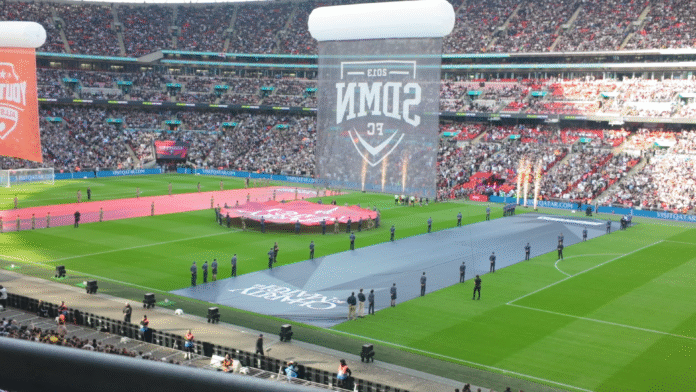Football is changing, and fast.
For decades, commercial revenue in the sport was largely dominated by traditional routes: shirt sponsorships from betting companies, broadcast rights sold to TV giants, and big-name brand endorsements centred around elite clubs and superstar athletes.
But the rise of YouTube football and leagues like Baller League UK are rewriting that script. Built around digital creators, direct-to-fan engagement, and viral storytelling, these new models are turning entertainment-first football into serious business, and bringing in serious sponsors.
Despite accusations of this being a gimmick or publicity stunt, the reality appears to be the start of a new era in football commercialisation.
The Digital Football Boom
Leagues like Baller League UK and events like the Sidemen Charity Match are attracting millions of views online, filling major stadiums, and offering brands something increasingly rare in modern sport: cultural relevance, audience loyalty, and immediate digital impact.
“YouTube football has transformed sponsorship into storytelling, offering brands reach and cultural capital traditional sport struggles to deliver.”
Unlike traditional leagues that rely heavily on linear TV deals and heritage fanbases, these creator-led formats thrive on digital platforms like YouTube and Twitch, where monetisation happens in real time, community feedback is instant, and content lives far beyond the 90 minutes of play.
The commercial response has been significant.
The Sidemen Charity Match: Sponsored Like a Premier League Fixture
The 2025 Sidemen Charity Match which took place at Wembley Stadium on 8th March 2025 was backed by high-profile sponsors including Footasylum, who confirmed their role as one of the headline partners.
Their branding appeared on the official Sidemen shirts, around the stadium, and across digital content filmed on the day. Brands like Footasylum are investing in storytelling, content capture, and access to an audience they cannot reach through traditional sport or advertising.
This kind of activation reflects how YouTube football properties offer exciting commercial platforms as well as entertainment. And unlike traditional sport, they come with built-in reach, content strategy, and cultural capital.
Baller League UK: Powered by Brands, Fueled by Engagement
Perhaps the most ambitious project to date is Baller League UK, a slick, competitive, creator-led football league launched in partnership with Virgin Media O2.
O2, the league’s headline sponsor, plays a central role. Their branding is visible across all touchpoints, but they’ve gone further, offering exclusive match tickets and VIP perks to their customers via the O2 Priority app. This is a great example of integrated brand utility beyond a simple sponsorship package.
The league also boasts a roster of other sponsors including:
- CUPRA, the automotive brand, which aligns with Baller League’s challenger positioning, appealing to younger audiences.
- Grenade, the nutrition brand, who turned games into sampling opportunities and created activations in the fan zone.
- Shikenso Analytics, bringing data-driven insights to measure sponsor value and engagement.
- Pepsi, Nike, Philips, Head & Shoulders, who all backed the debut season, showing mainstream confidence in the format.
International expansion is already underway. In Germany, XING, the professional networking platform, serves as a main sponsor, connecting with working professionals in a fresh setting.
Content, Community, and Commercial Scale
One of the key reasons brands are turning to YouTube football is control. These leagues understand content, and they deliver it daily. Players are mic’d up, behind-the-scenes stories are filmed, special guests are part of the programming.
In Baller League UK, YouTuber Chunkz and broadcaster Olivia Buzaglo host the matches, with celebrity appearances from figures like Will Smith and professional footballer Kevin Danso. These integrations give fans a reason to tune in beyond just the final score.
“Baller League UK combines football, entertainment, and digital-first storytelling to engage fans and brands like never before.”
The entire league is broadcast for free on YouTube and Twitch, pulling in huge audiences and giving sponsors unmatched digital visibility. Even Sky Sports showed the first season on Sky Sports Mix under a one-year deal, with more rights talks already in progress.
Why It Works, And What It Means for Football
These new formats succeed because they do three things exceptionally well:
- They make football entertaining again – lighter tone, relatable players, and viral content that blends competition with creator culture.
- They put fans at the centre – interactivity, fan votes, and campaigns that make supporters feel like participants.
- They offer measurable, agile marketing – sponsors can track real-time data, making investments easier to justify.
Traditional football will always have a place, but its pace and structures are slow compared to the agility of YouTube football and creator-led leagues.
The Future: Creator Presidents and Global Growth
The model is going global. A US edition of Baller League is launching soon, with YouTuber iShowSpeed announced as its President. This shows how creator-led sport is embedding itself in entertainment and commercial landscapes.
As these leagues grow, expect to see:
- Bigger brand integrations
- Expanded global editions
- Co-branded merchandise and digital assets
- Sophisticated media partnerships
- Athletes who think like creators, not just players
Final Thought
YouTube football and leagues like Baller League UK are far more purposeful than simple viral sideshows. By mixing the structure of elite sport with the flexibility of digital content, they offer brands, fans, and players a new playbook for value creation.
The real game has only just begun.

